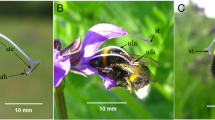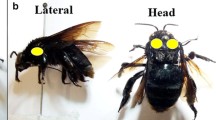Abstract
Distyly is a floral polymorphism, characterized by a reciprocal positioning between stigmas and anthers in different flowers, where two floral morphs, long-styled (pin) and short-styled (thrum) occur within the population. Distyly is suggested as one of the routes leading to the evolution of separate sexes in plants. In this evolutionary pathway, pollinators may disrupt the complementarity of pollen transfer between morphs. Consequently, the floral morphs gradually specialize as either male or female. A key process required for gender specialization in distylous plants is a deviation of the realized functional gender (i.e. the proportion of genes transmitted to the next generation via pollen donation and seed production) from the potential functional gender (i.e. the expected contribution of male and female function to reproductive success from the number of ovules or pollen grains produced by each morph). I selected the distylous herb Arcytophyllum lavarum (Rubiaceae) to determine if asymmetry in pollen flow promotes differences in seed production, pollen donation and a discrepancy between the potential and the realized functional genders in pin and thrum floral morphs. Pollen flow in A. lavarum is asymmetric and the pin morph is more efficient at performing cross-pollination than the thrum morph. Conversely, the thrum morph produced two times more seeds than the pin morph. Male and female contributions to the potential functional gender were equivalent in both morphs. However, the pin morph transmitted more genes through pollen donation and the thrum morph more through seed production than expected from their potential functional genders. These results support the hypothesis that if pollinators consistently promote asymmetric pollen flow between morphs over generations, it is possible that gender specialization may evolve to the extreme of dioecism from an original distylous condition.




Similar content being viewed by others
References
Charlesworth D (1999) Theories of the evolution of dioecy. In: Geber MA, Dawson TE, Delph LF (eds) Gender, sexual dimorphism in flowering plants. Springer, Berlin, pp 33–60
Charlesworth D, Charlesworth B (1979) A model for the evolution of distyly. Am Nat 114:467–498
Cliff AD, Ord JK (1981) Spatial processes: models and applications. Pion. London, England
Darwin C (1896) The different forms of flowers on plants of the same species. D. Appleton and Company, New York
Devlin B, Stephenson AG (1987) Sexual variations among plants of a perfect-flowered species. Am Nat 130:199–218
Dommee B, Thompson JD, Cristini F (1992) Distyly in Jasminum fruticans. An hypothesis for optimal pollination based on variation in intrafloral ecology. B Soc Bot Fr-Lett 139:223–234
Freeman DC, Doust L, El-Keblawy A, Miglia KJ, McArthur ED (1997) Sexual specialization and inbreeding avoidance in the evolution of dioecy. Bot Rev 63:65–92
Ganders FR (1979) The biology of heterostyly. New Zeal J Bot 17:607–635
García-Robledo C, Mora F (2007) Pollination Biology and the impact of floral display, pollen donors and distyly on seed production in Arcytophyllum lavarum (Rubiaceae). Plant Biol 9:453–461
Horovitz A (1978) Is the hermaphrodite flowering plant equisexual? Am J Bot 65:485–486
Husband BC, Barrett SCH (1992) Pollinator visitation in populations of tristylous Eichhornia paniculata in Northeastern Brazil. Oecologia 89:365–371
Kohn JR, Barrett SCH (1992a) Experimental studies on the functional significance of heterostyly. Evolution 46:43–55
Kohn JR, Barrett SCH (1992b) Floral manipulation reveal the cause of male fitness variation in experimental populations of Eichornia paniculata (Pontederiaceae). Funct Ecol 6:590–595
Lau P, Bosque C (2003) Pollen flow in the distylous Palicourea fendleri (Rubiaceae): an experimental test of the disassortative pollen flow hypothesis. Oecologia 135:593–600
Link N, Albinger G, Fontes A (1994) Sigma scan. Jandel Corporation, Chicago
Lloyd DG (1980) Sexual strategies in plants III. A quantitative method for describing the gender of plants. New Zeal J Bot 18:103–108
Lloyd DG, Webb CJ (1992) The selection of heterostyly. In: Barrett SCH (ed) Monographs in theoretical and applied genetics 15: evolution and function of heterostyly. Springer-Verlag, New York, pp 179–207
Luteyn JL (1999) Páramos: a checklist of plant diversity, geographical distribution, and botanical literature. New York Botanical Garden Press, Bronx, NY
Naiki A, Nagamasu H (2003) Distyly and pollen dimorphism in Damnacanthus (Rubiaceae). J Plant Res 116:105–113
Oneil P (1992) Variation in male and female reproductive success among floral morphs in the tristylous plant Lythrum salicaria (Lythraceae). Am J Bot 79:1024–1030
Ornduff R (1980) Heterostyly, population composition, and pollen flow in Hedyotis caerulea. Am J Bot 67:95–103
Ornelas JF, Gonzalez C, Jimenez L, Lara C, Martinez AJ (2004) Reproductive ecology of distylous Palicourea padifolia (Rubiaceae) in a tropical montane cloud forest. II. Attracting and rewarding mutualistic and antagonistic visitors. Am J Bot 91:1061–1069
Pailler T, Thompson JD (1997) Distyly and variation in heteromorphic incompatibility in Gaertnera vaginata (Rubiaceae) endemic to La Reunion Island. Am J Bot 84:315–327
Pannell JR, Verdu M (2006) The evolution of gender specialisation from dimorphic hermaphroditism: paths from heterodichogamy to gynodioecy and androdioecy. Evolution 60:660–673
Ree RH (1997) Pollen flow, fecundity, and the adaptive significance of heterostyly in Palicourea padifolia (Rubiaceae). Biotropica 29:298–308
Ross MD (1982) Five evolutionary pathways to subdioecy. Am Nat 119:297–318
Sokal RR, Rohlf FJ (1995) Biometry: the principles and practice of statistics in biological research, 3rd edn. W.H. Freeman, New York
Stone JL (1995) Pollen donation patterns in a tropical distylous shrub (Psychotria suerrensis Rubiaceae). Am J Bot 82:1390–1398
Stone JL, Thomson JD (1994) The evolution of distyly - Pollen transfer in artificial flowers. Evolution 48:1595–1606
Weber H (1959) Los páramos de Costa Rica y su connotación fitogeográfica con los Andes suramericanos. Instituto Geográfico, San José, Costa Rica
Wolfe LM, Barrett SCH (1987) Pollinator foraging behavior and pollen collection on the floral morphs of tristylous Pontederia cordata L. Oecologia 74:347–351
Wyatt R, Hellwig RL (1979) Factors determining fruit set in heterostylous bluets, Houstonia caerulea (Rubiaceae). Syst Bot 4:103–114
Acknowledgements
I especially thank Federico Valverde, Hilario Abarca and Eliecer Abarca (Estación Biológica Cerro de La Muerte) J. Mora and F. Kepfer for logistic support and F. Mora for assisting during part of the data collection. Image analyses were performed in the Auditory Neurobiology Laboratory, University of Miami and the Entomology Laboratory, University of Costa Rica. S. Tomchik and Dr. Z. (John) Lu provided invaluable advice during image analyses. Charlotte M. Taylor determined the Arcytophyllum species. I thank A. C. Villegas as the advisor of this project at the Organization for Tropical Studies. Comments by S. Koptur, E. K. Kuprewicz and three anonymous reviewers improved this manuscript. Part of the equipment used in this research was provided by IDEA-WILD This research was supported by the Organization for Tropical Studies – Glaxo fellowship for Latin–American researchers (Fund No.502) to C.G. Laboratory and data analyses were supported by the Aldridge Assistantship and the J. McLamore Fellowship, - University of Miami, both to C.G. This project was honored with the Alwyn Gentry Award 2004, Association for Tropical Biology and Conservation.
Author information
Authors and Affiliations
Corresponding author
Rights and permissions
About this article
Cite this article
García-Robledo, C. Asymmetry in pollen flow promotes gender specialization in morphs of the distylous neotropical herb Arcytophyllum lavarum (Rubiaceae). Evol Ecol 22, 743–755 (2008). https://doi.org/10.1007/s10682-007-9198-0
Received:
Accepted:
Published:
Issue Date:
DOI: https://doi.org/10.1007/s10682-007-9198-0




